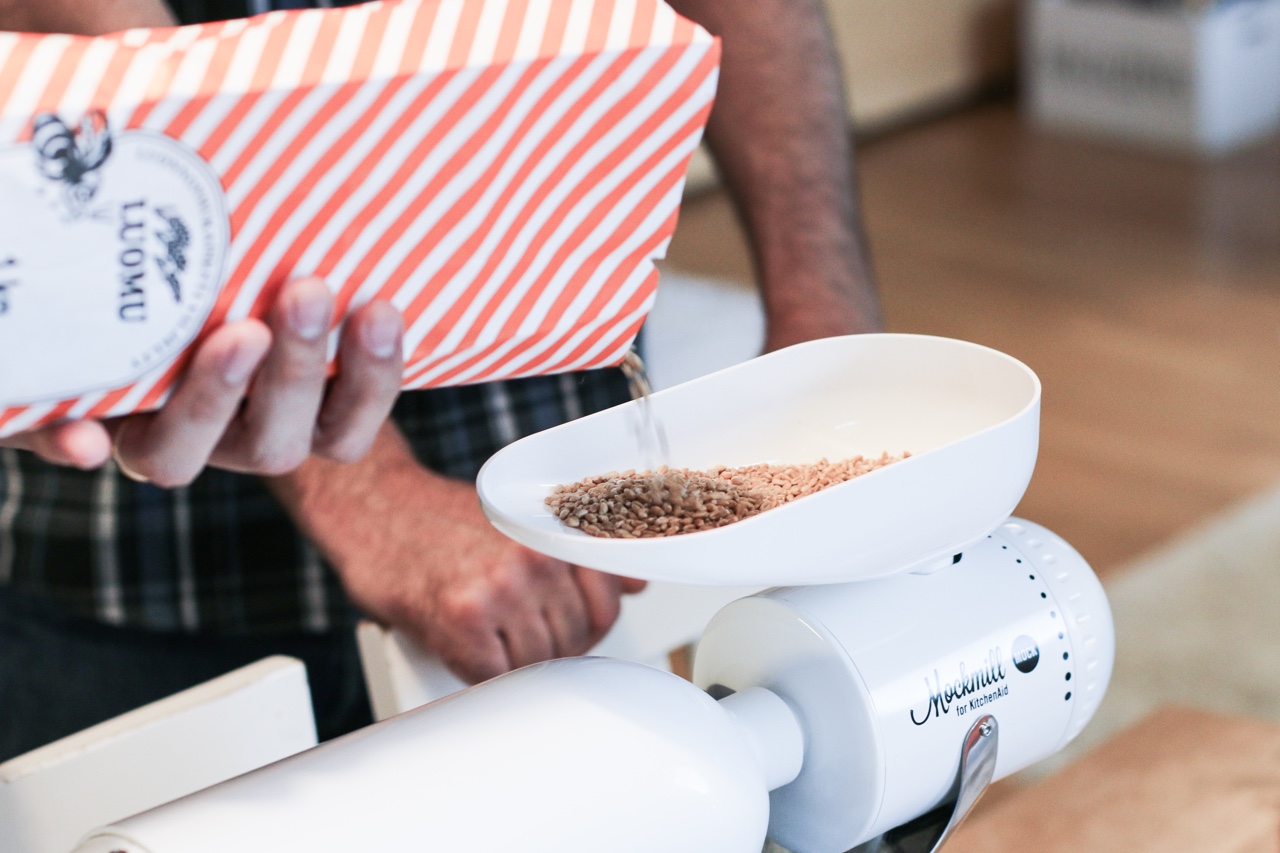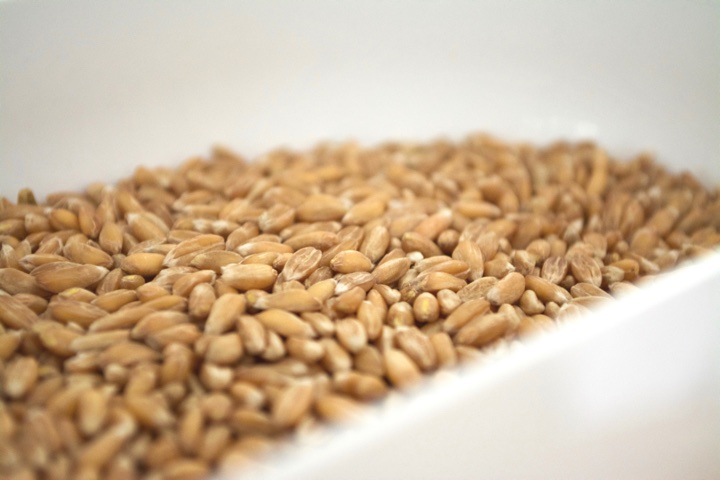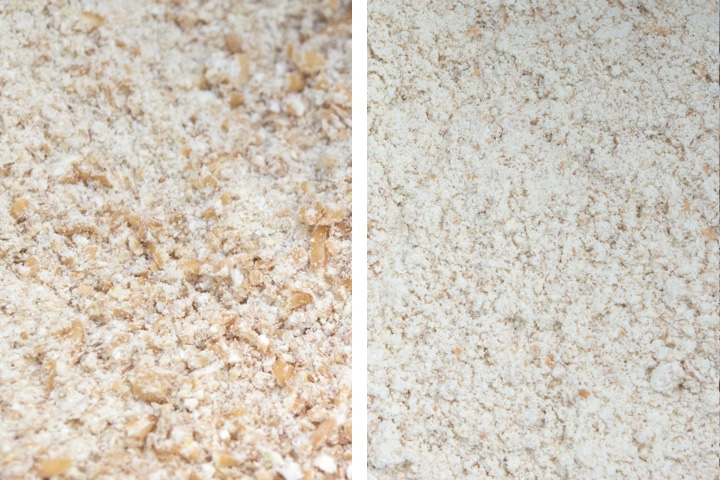Getting Started With Home Milling

“I never realized flour too is a fresh product,” my wife said to me as she mixed a cookie dough using home milled spelt flour, visibly excited about how different it smelled and felt compared to store-bought white flour.
In saying that, she put a common belief into words. Flour, as most of us see it, is a commodity product with a long shelf-life and little nutritional value.
But why is that?
A grain of wheat, before it gets milled into flour is full of nutrients sealed inside a protective layer of bran. Once you grind the grain into flour, that seal is broken, and the contents – most importantly, the fats in the germ – get exposed to the environment. Within a few months, depending on temperature, the amount of oxygen available, and moisture, the flour will go rancid, and will no longer be suitable for baking.
Such a short keeping time is no good for mass production, and so, some hundred plus years ago, new milling practices were invented to change this. With the new tools, industrial millers could get rid of the parts that made the flour go bad – the bran and germ, leaving just a white flour that could be stored for a long time and transported far away.
At the time, we didn’t know enough about nutrition to complain.
It wasn’t until much later that scientists realized the health benefits of whole-grain flours. Then, in response to a growing demand for whole-grain flour, industrial millers started producing “whole grain flour” by mixing bran back into their white flour – still leaving the germ out, which is what most still do today. That’s because besides being one of the most nutritious parts of the grain, the germ is also the quickest to spoil!
**
In addition to these well-documented qualities of whole grain flours, there are some stronger claims about fresh flour and the way many of the vitamins in it get degraded in just hours after milling. The science is not straightforward enough to reduce to a simple “do this” or “do that”, and I can’t claim to understand it all. I think those claims should be taken with a grain of salt, even if there probably is truth in them.
Fresh flour smells and tastes very different compared to one that has been milled weeks earlier. Which, to me, means that freshness matters.
But, if you agree that flour is a fresh product, what should you do about it?
How do you bring that realization into action?
The good news is that, around the world, people are getting more and more interested in grain. Following in the footsteps of the “farm to table” movement, bakers are realizing that a direct connection to the farmer who grows the wheat and other cereals can help them make bread that is not only healthier, tastier, and better for the environment but also good for the vitality of their communities.
Some bakeries have decided to start milling their flours, others work in close cooperation with millers, and in some cases, the farmers are the ones also milling their production. Ancient and heritage varieties of wheat are making a comeback as we are finding that they can be easier to digest than the modern, more aggressively bred varieties.
That means that if you are lucky, you can even find an artisan mill in your hometown to provide you with the fresh flour you need for your baking. Our contributor, Barbara ‘Elisi’ Caracciolo is currently in the process of starting one in Stockholm!
But such millers are still few, and so, most of us are limited to two options: we can buy one of the few options of bagged flour our local store has decided to stock, or we can mill our own.
How I Got Started With Home Milling
In my years as a home baker, I have often looked longingly at the mills some bakers use to make flour in their homes – but never got to trying my hand at one. So, while I knew about the benefits from articles such as this one by Maurizio Leo, my interest was mostly theoretical.
Then, out of the blue, this spring, I received a message from Paul Lebeau, managing director of the home mill company Wolfgang Mock.
“Does the name Wolfgang Mock say anything to you?” he asked me.
As I hesitated, he continued to explain that Wolfgang Mock was the “Wo” in HaWo’s and “Mo” in KoMo, two of the best-known mill makers in Europe. That rang a bell.
Paul told me that after thirty-five years designing and making home mills, Wolfgang Mock had now created a mill attachment to stand mixers that they believe will bring milling to a much wider audience than ever before.

I was eager to hear more, so they sent me a mill for testing.
Then, in June, I had the chance to visit Wolfgang, Paul, and their families at the company’s headquarters in Otzberg, a beautiful village near Frankfurt, in Germany. We baked together, and we talked about bread and wholegrain flour.
As I interviewed Wolfgang for my article in issue 19 of Bread Magazine, he told me that his goal since his first mills 35 years ago has been to “see a mill in every household, every kitchen.” But he didn’t stop there. He added that he doesn’t even care so much if it’s one of his mills or a mill from another brand!
Mockmill
After years of making stand-alone mills, Wolfgang knew that to reach the mainstream customers, he needed to change the way mills are made. While a hardcore home miller will happily pay a premium to have a stand-alone mill on his or her countertop, for most people the idea still feels too foreign for them to jump in.
Then he realized that a lot of people already have a stand mixer – and more are getting one every year. And stand mixers had motors!
By attaching the mill to a mixer, he could eliminate the need for a motor and make the mill much more affordable without sacrificing quality.
That’s when Mockmill was born.

The mill can be attached to AEG, Electrolux, KitchenAid, or Kenmore stand mixers, and so Mockmill answers the common objections: cost and space.
If you already have the mixer, a Mockmill is a wonderful, affordable way to get started with home milling. Equipped with durable corundum stones and designed with care to detail, this is a quality product, and very easy to use. Its stones have been specifically designed so they won’t wear down the motor in the mixer – in fact, Wolfgang told me that he first designed them to be used in a hand mill!
And as the mill hooks into your mixer, you don’t need to reserve extra space for it!
The Mockmill is a fully functional stone mill that can serve you for years to come while still being affordable enough to use as an entry level tool if you’re not ready to invest in or don’t need a bigger mill.
On the other hand – and this also needs to be said – if you don’t have a mixer and don’t need one for other purposes, you won’t benefit from the cost and space savings that come with a Mockmill. In this case, this isn’t the mill for you.
What I’ve Learned So Far
After a few months of baking bread with home-milled flour, I’m hooked.
I’m still a beginner at home milling, but I’m loving it – maybe for that very reason, even.
Here are some of my early impressions and lessons learned so far. Many of them are also reasons why I’d like to encourage you to at least consider the idea of home milling.
In the end, we probably won’t all be milling our flour, and we don’t need to be. If enough of us do, that will already change the world in meaningful, interesting ways that I believe will bring fresh flour into all of our hands, making life a little better and more enjoyable.
1. Freshly Milled Flour Tastes Better
Let’s begin with what you’ll notice first.
Fresh flour smells, feels and tastes quite different compared to any flours you will find in the store.
At first, I attributed this to the different grains I was using, and I’m still sure they play a part. But mostly, it’s about freshness. In a recently milled flour, the flavors are all still present.
If you’ve been following my writing for a while, you probably know that I’m a big fan of white bread. So, when I say that I now enjoy whole-grain bread in a whole new way, it’s a big change for me. The added boost in taste that I get from using freshly milled flour just makes the bread so much more interesting to me.

2. Sourcing Grain Takes Work But Can Be Fun
If the selection of flours in stores is limited, in most places, the selection of grains is even more so. And, as a reader pointed to me in an email, the price may often be even higher than that of flour. At first, it feels counter-intuitive but becomes understandable when you think about how few of us buy those grains.
I have been buying my grains from many sources and with highly differing prices: once I got a bag of spelt sold as “spelt rice” for a high premium. It worked well, but the price made no sense. At other times, I have bought packages of 1 kg for a reasonable price, but still at a premium, at my local supermarket.
But the approach I’ve enjoyed the most has been a direct connection with the farmer. In fact, today, I just bought five kilos of wheat from a farmer through a Facebook-based organic food ring. The producer was offering flour for sale, but I noticed that they milled it themselves, using their own grain. So, I asked her if she’d sell me some grain to mill myself. She agreed.
If I were living further away, I’d probably get a much bigger bag of grain to use to keep the transport costs at bay. Luckily, while properly milled flour is a fresh product that should be consumed soon after milling, grains can be stored for years in proper conditions. This way, buying grain in bulk may even lead to cost savings in the long run.
3. A Mill Will Fuel Your Curiosity
But finding grain for milling isn’t just another source of complexity, it’s also an amazing way to find inspiration.

Years ago, the reason I started making bread was curiosity. I wanted to know how it’s made, to understand the mysterious processes of fermentation, and to push the limits of what I can do in my home kitchen.
Now, I’m finding that home milling gives me still more things to be amazed by.
As I mill my own flour, I’m not limited by the grain a miller decides to use to make the flour sold at my local supermarket. I can buy whatever grain I can find and see what I can do with it. The number of combinations to play with is huge: I can vary the ingredients I use, the way I grind them, and experiment.
Most store-bought wheat flour, for example, is made by first extracting the bran and then mixing it back with the white flour. This results in flour with big flakes of bran, making the flour rather coarse. On the other hand, working with the Mockmill, I often turn the dial to the finest setting that suits the grain I’m using. This way, I get a very fine flour that still has everything from the whole grain in it!
Sometimes, I end up sifting the flour – but less and less these days, and that too is an interesting experiment: what is left behind, and how it differs based on the grind setting.
Milling is a field of its own, and while some will say that that’s a reason to leave it to the professionals, for me it’s a reason for doing it!
4. There’s No Need to Stop Using White Flour
While using the whole grain makes a lot of sense nutritionally, ecologically, and often for the added taste, I still believe there are a time and place for white flour too. It doesn’t have to be all or nothing.
Maybe your family enjoys an occasional sandwich bread?
Maybe you prefer to make your pastries with white flour?
Maybe you like white baguettes?
If that’s the case, go ahead and grab a bag of white flour from the store. Or sift your home milled flour into a low-extraction (a lower percentage of the grain in final flour) flour. You can also mix store-bought flour with your home-milled whole grain flour.
It’s all allowed. Having a mill at home only gives you more opportunities to decide what your final product will be like.
5. It’s Not Just About Bread
One of the surprising things about home milling that I hadn’t even considered before was how having a mill in the kitchen would affect the rest of my cooking.
These days, I often make my porridges with grain milled at a very coarse setting in the Mockmill. Often, I also cook the sifted out bran into a nice, dark brown porridge. My wife loves to use the Mockmill for wholegrain biscuits and cookies.
In all, the mill is making my kitchen a more interesting place and helping me use different grains in new and inspiring ways.
In all, if you are curious, I wholeheartedly recommend adding this skill to your inventory.
**
Finally, here’s a short video of the Mockmill making some fresh spelt flour for my bread.
https://vimeo.com/178004392